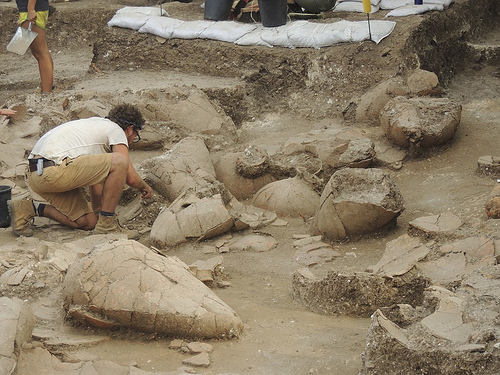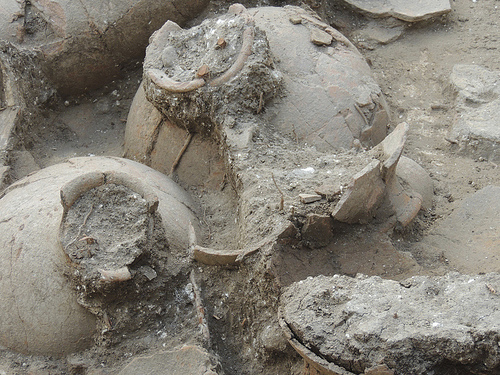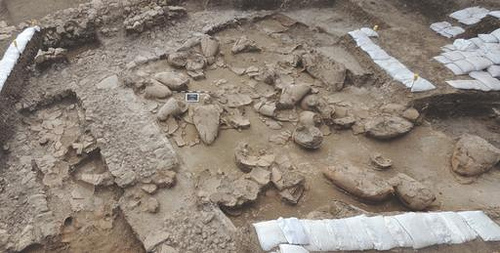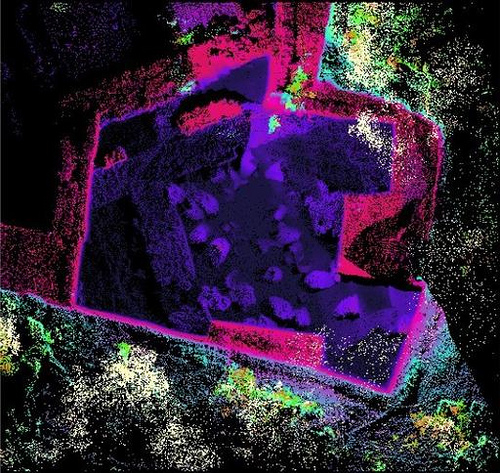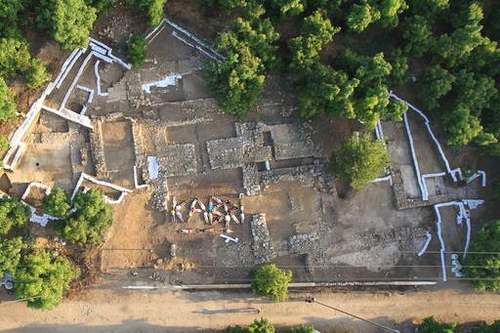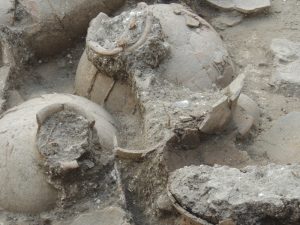 These 3,700-year-old jars were discovered in an ancient palatial wine cellar unearthed by researchers at Tel Kabri in July 2013. The team worked in day and night shifts to excavate a total of 40 intact vessels during its six-week dig.Credit: Eric H. Cline, George Washington University
These 3,700-year-old jars were discovered in an ancient palatial wine cellar unearthed by researchers at Tel Kabri in July 2013. The team worked in day and night shifts to excavate a total of 40 intact vessels during its six-week dig.Credit: Eric H. Cline, George Washington University While excavating within the palace ruins of Tel Kabri, a 75-acre ancient Canaanite city site in northern Israel that dates back to 1700 BCE, a joint American-Israeli team came across a three-foot-long jar. They later christened it “Bessie.” The single find by itself was nothing remarkable. But they kept digging.
“We dug and dug, and all of a sudden, Bessie’s friends started appearing—5, 10, 15, ultimately 40 jars packed in a 15-by-25-foot storage room,” said excavation co-director Dr. Eric Cline, chair of George Washington University’s Department of Classical and Near Eastern Languages and Civilizations within the Columbian College of Arts and Sciences. “This is a hugely significant discovery—it’s a wine cellar that, to our knowledge, is largely unmatched in its age and size.”
______________________________________________________________________________________________________________________
The team worked in day and night shifts to excavate a total of 40 intact 3,700-year-old vessels in the ancient palatial wine cellar during its six-week dig in July 2013. Courtesy Eric Cline
______________________________________________________________________________________________________________________
Detail view of some of the ancient wine jars unearthed at Tel Kabri. Courtesy Eric Cline
________________________________________________________________________________________________________________________
The 40 jars, each of which could have held 50 liters, had a total capacity of about 2,000 liters, meaning the cellar could have held the equivalent of nearly 3,000 bottles of red and white wine. This places the cellar among the largest ancient wine cellars in the world.
The finds were made while they were digging an area adjacent to and west of a monumental building first excavated in 2011, a one-of-kind structure that was lined with precisely-shaped orthostat blocks.
“This is the largest concentration to date of restorable pottery found anywhere in the palace of Kabri and the only place on site where we have found an entire room still full of artifacts,” writes co-director Yasur-Landau and colleagues in their preliminary report. Yasur-Landau is chair of the Department of Maritime Civilizations at the University of Haifa.
They add that it is “the first time that such a storeroom with jars still present has been uncovered within an MB (Middle Bronze Age) palace in Canaan.”
What is more, “the wine cellar was located near a hall where banquets took place, a place where the Kabri elite and possibly foreign guests consumed goat meat and wine,” said Yasur-Landau. “The wine cellar and the banquet hall were destroyed during the same violent event, perhaps an earthquake, which covered them with thick debris of mud bricks and plaster.”
________________________________________________________________________________________________________________________
Overall view of the excavated storage room with jars. The room measured approximately 15-by-25 feet, and held 40 wine jars that were 3,700 years old. Courtesy Eric Cline
_______________________________________________________________________________________________________________________
This image of the Tel Kabri wine cellar was created using LIDAR, a technique that uses a pulsed laser to measure distances and generate an accurate 3D map of a location. LIDAR helped the archaeologists map the storage room and each of the 40 wine jars discovered in July 2013. Courtesy Tel Kabri Archaeological Project
_______________________________________________________________________________________________________________________
At first, it wasn’t clear that the jars once contained wine. To determine that, Dr. Koh, an assistant professor of classical studies at Brandeis University and associate director of the excavation, analyzed the jar fragments using organic residue analysis. He found traces of tartaric and syringic acids, both key components in wine, as well as compounds suggesting the presence of ingredients popular in ancient wine-making, including honey, mint, cinnamon bark, juniper berries and resins. The recipe is similar to medicinal wines used for 2,000 years in ancient Egypt.
“This wasn’t moonshine that someone was brewing in their basement, eyeballing the measurements,” Dr. Koh said. “This wine’s recipe was strictly followed in each and every jar.”
Researchers now want to continue analyzing the composition of each solution, possibly discovering enough information to recreate the flavor.
Archaeologists anticipate the possibility of more storage rooms ahead. A few days before the end of the 2013 field season, they discovered two doors leading out of the wine cellar—one to the south, and one to the west. They suspect they lead to other storage rooms. But they will have to wait another two years — the next field season doesn’t start until the summer of 2015.
Tel Kabri contains the remains of a Canaanite palatial center dated to the Middle Bronze Age (2,000-1,550 BCE). First settled about 16,000 years ago during the Neolithic period, permanent structures began to appear around 10,000 BCE. Excavations were conducted at Tel Kabri from 1986 to 1993 under Israeli archaeologist Aharon Kempinski, and then renewed beginning in 2005 by an international team co-directed by Assaf Yasur-Landau of the Leon Recanati Institute for Maritime Studies at the University of Haifa and Prof. Eric H. Cline of The George Washington University. Tel Kabri is best known for its Minoan-style frescoe fragments, the only such finds ever unearthed in Israel. Beginning in 2009, fragments of additional Minoan style frescoes were discovered at the site.
Ultimately, the researchers hope the Tel Kabri excavations and research will offer what might be the most complete picture of palatial political, social and economic life in the Canaanite period, answering questions such as whether or not the Canaanites had a central government, whether taxes were levied, the type of agriculture practiced, and the trade networks operating during the time.
_______________________________________________________________________________________________________________________
An aerial view of Tel Kabri. Among other objectives, researchers are investigating the site to obtain clues as to what drove the economy of the area. Courtesy Skyview Photography, Ltd.
_______________________________________________________________________________________________________________________
Source: Adapted and edited from press releases of the George Washington University and Brandeis University and a previous article published by Popular Archaeology Magazine, Archaeologists Uncover Rare Finds at an Ancient Canaanite Center.
_______________________________________________________________________________________________________________________
Read about the most fascinating discoveries with a premium subscription to Popular Archaeology Magazine. Find out what Popular Archaeology Magazine is all about. AND MORE:
 Popular Archaeology’s annual Discovery edition is a selection of the best stories published in Popular Archaeology Magazine in past issues, with an emphasis on some of the most significant, groundbreaking, or fascinating discoveries in the fields of archaeology and paleoanthropology and related fields. At least some of the articles have been updated or revised specifically for the Discovery edition. We can confidently say that there is no other single issue of an archaeology-related magazine, paper print or online, that contains as much major feature article content as this one. The latest issue, volume 2, has just been released. Go to the Discovery edition page for more information.
Popular Archaeology’s annual Discovery edition is a selection of the best stories published in Popular Archaeology Magazine in past issues, with an emphasis on some of the most significant, groundbreaking, or fascinating discoveries in the fields of archaeology and paleoanthropology and related fields. At least some of the articles have been updated or revised specifically for the Discovery edition. We can confidently say that there is no other single issue of an archaeology-related magazine, paper print or online, that contains as much major feature article content as this one. The latest issue, volume 2, has just been released. Go to the Discovery edition page for more information.
Subscription Price: A very affordable $5.75 for those who are not already premium subscribers of Popular Archaeology Magazine (It is FREE for premium subscribers to Popular Archaeology). Premium subscribers should email [email protected] and request the special coupon code. Or, for the e-Book version, it can be purchased for only $3.99 at Amazon.com.

